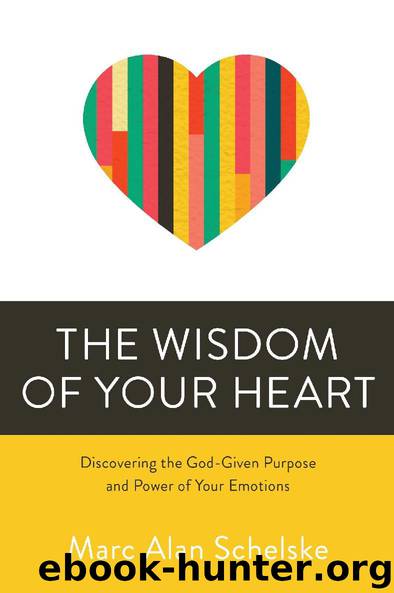The Wisdom of Your Heart by Marc Alan Schelske

Author:Marc Alan Schelske [Schelske, Marc Alan]
Language: eng
Format: epub
Tags: REL012000 Religion / Christian Life / General
Publisher: David C Cook
DIFFERENT EMOTIONS CARRY DIFFERENT INFORMATION
A change happens in our external circumstances or internal states. Our emotions respond. The sequence unfolds: First, there is a change in body state. Almost simultaneously, a cocktail of thoughts associated with those bodily responses emerges. Then we become aware of the object we’re reacting to with a gut-level sense of push or pull. This leads to the near-immediate formulation of a story explaining what we’re feeling and why. All of this is usually experienced in almost simultaneous succession.
This process can deliver an incredibly wide range of information. We have many different emotions. Those emotions can have different meanings in different contexts. Sometimes we feel multiple emotions simultaneously, or even conflicting emotions, which makes life all the more exciting—or confusing.
Quite a number of researchers and theorists have devised ways of categorizing emotions. These lists are never entirely accurate or comprehensive, but they can be helpful as you begin paying attention to your emotions. The framework I found most helpful is called Plutchik’s Wheel of Emotions. 9
Dr. Robert Plutchik suggested there are eight basic emotions—terror, rage, vigilance, amazement, ecstacy, grief, admiration, and loathing—which he presented in four pairs: anger and fear, anticipation and surprise, joy and sadness, trust and disgust (see table 1). You may even notice the push and pull in each pairing.
Anger and fear are responses to a threat, obstacle, or violation. One response retreats from the object; the other aggressively moves toward it. Anticipation and surprise are responses to something new or uncertain. Anticipation is what we feel as we head into new territory. Surprise is the response we feel when confronted with the unexpected. Joy and sadness are responses connected to what we hold dear. We feel sadness when we lose something that matters to us; joy emerges when we gain something important. Trust and disgust are emotional responses related to acceptance and connection. Trust is the emotion that draws us toward something or someone we accept and feel connected to. Disgust is the response that pushes us away from something unpalatable or socially unacceptable.
Emotion Content How We See the Object Our Intuitive Response
Emotions are not subjective, but our interpretations are. Remember that we define our emotions always in relationship to our own view of the circumstances. A good way to keep this in mind is to describe each emotion with the sentence “_________ is the emotion you feel when, in your own personal logic, you or someone or something that matters to you has been _________.”
Download
This site does not store any files on its server. We only index and link to content provided by other sites. Please contact the content providers to delete copyright contents if any and email us, we'll remove relevant links or contents immediately.
The 5 Love Languages: The Secret to Love That Lasts by Gary Chapman(8543)
The Space Between by Michelle L. Teichman(6100)
Assassin’s Fate by Robin Hobb(5258)
Wiseguy by Nicholas Pileggi(4610)
Everything Happens for a Reason by Kate Bowler(4076)
Gerald's Game by Stephen King(3931)
A Simplified Life by Emily Ley(3584)
The Power of Positive Thinking by Norman Vincent Peale(3466)
Pillow Thoughts by Courtney Peppernell(3427)
Resisting Happiness by Matthew Kelly(2896)
Girl, Wash Your Face by Rachel Hollis(2832)
Being Aware of Being Aware by Rupert Spira(2718)
Name Book, The: Over 10,000 Names--Their Meanings, Origins, and Spiritual Significance by Astoria Dorothy(2500)
Real Sex by Lauren F. Winner(2489)
More Language of Letting Go: 366 New Daily Meditations by Melody Beattie(2458)
The Holy Spirit by Billy Graham(2435)
Fast Facts on Defending Your Faith by John Ankerberg & John Weldon(2398)
Victory over the Darkness by Neil T. Anderson(2395)
The Secret Power of Speaking God's Word by Joyce Meyer(2264)
